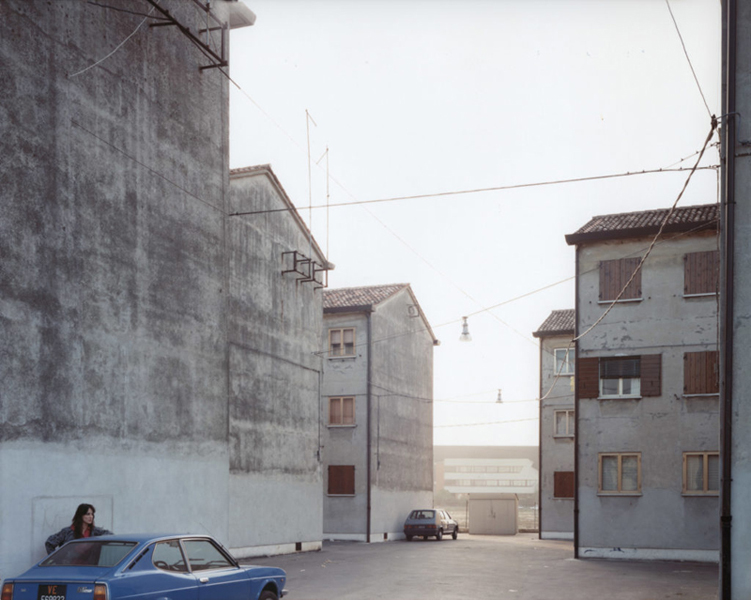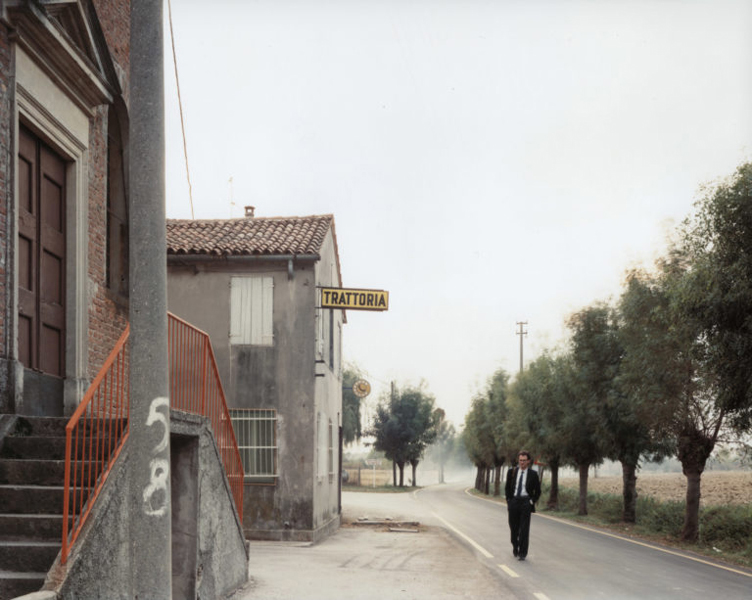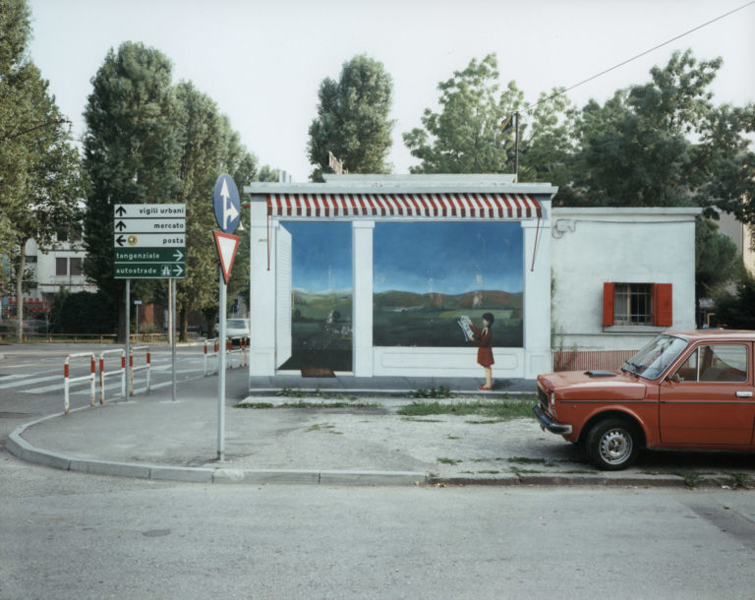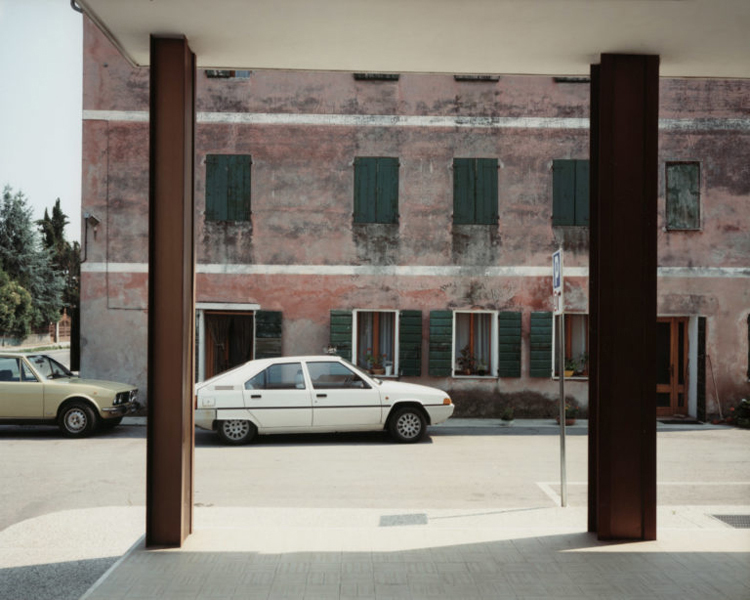
Veneto | Living traces
A foreword to Guido Guidi's Veneto Series by Ganko
“Le temps qui passe (mon Histoire) dépose des résidus qui s‘empilent : des photos, des dessins, des corps de stylos-feutres depuis longtemps desséchés, des chemises, des verres perdus et des verres consignés, des emballages de cigares, des boîtes, des gommes, des cartes postales, des livres, de la poussière et des bibelots : c‘est ce que […]
“Le temps qui passe (mon Histoire) dépose des résidus qui s‘empilent : des photos, des dessins, des corps de stylos-feutres depuis longtemps desséchés, des chemises, des verres perdus et des verres consignés, des emballages de cigares, des boîtes, des gommes, des cartes postales, des livres, de la poussière et des bibelots : c‘est ce que j‘appelle ma fortune.”
Georges Perec
“To live is to leave traces.” (1); thus reads one of Walter Benjamin’s most notorious aphorisms. The statement is not so obvious as to present no difficulties. Above all and contrary to what one might expect it is not about melancholy; not only at least.
We live in a time dominated by the categories of abstraction and indifference; a time of definitive erasure of specificity and ultimate interchangeability: the era of the generic. „Liberated from the straitjacket of identity“ (2), everything is reduced to communication flow; rootlessly free to move from anywhere to anywhere; encountering no resistance, leaving no traces. Through the ubiquity of simulacra and the mass-mediatic conflation of time’s three horizons into an indissoluble ‘now’, we live in a condition of “eternal present” (3) where the possibility to address any sort of permanence seems to be precluded a-priori. The question is, in a world pervaded by distrust for the past and disillusion toward the future, how to turn our postmodern nihilism into simultaneously critical and operative tools. Is there any way to exploit our cynicism in order to readdress a proactive and authentic notion of life? Is there any way to use our disillusion? Certainly, since Benjamin’s times, to leave traces may have become increasingly difficult. Traces are something ephemeral, a locus of ambivalence suspended in the unstable space between construction and dispersal, presence and absence. (4) Nevertheless, although mostly unintentionally, we still do leave traces in our wake. Beyond the decay to which they bear witness, the mutability to which they testify, traces are also insistence, persistence, survival. No matter how fragile and trifling it might be; a trace is always an index of life.
The pictures that inspire this words share a sense of precariousness that is far remote from the mythic aura of timelessness that has enveloped today’s world. In all its inertia, the reality they portray is nevertheless provisional; still vulnerable to the vicissitudes of time.
With humbleness and discretion, these pictures pay homage to places that hold a strong value for their author, therefore distancing themselves also from the local indifference so typical of the globalism of our times. These picture ‘are’ the places he lives and, we can guess, he loves. Surely places he deeply experienced: his native region Emilia Romagna and its neighbouring region Veneto. Perhaps this autobiographism should discourage their intake as models for a reflection of a general nature but it is exactly the in-actuality of these images that constitutes a reason of compelling interest; being the outmoded insistence of their author on the definition of boundaries – the preliminary limitation of the field of investigation to the the well-known and the ordinary, the necessity of a solid anchorage to reality – not a contenitive work ultimately driven by the fear of chaos, but the act that makes its full exploitation and enjoyment ultimately possible.
With scientific accuracy these pictures follow life and its unfolding, accompanying the patient accumulation of its traces, their vanishing as well as their survival, in order to restitute us the sedimented history of a place. Combining the apparent detachment of an archive with the impossibility to establish an emotional distance from the object of their attentions, they subtly unveil a strong meditative charge. In these images the border between intuition and knowledge, analysis and affection, distance and intimacy continuously blur. With generosity, these pictures do not judge the life they record; they are not the medium conveying their author’s opinions, but simply the medium that allows us to share his experiences. Each picture is not only the record of a fleeting impression over the artist’s eye, but a thoughtful contribution to the understanding of a context that is plural from the very beginning; a background from which the photographer – as anybody else – can emerge only momentarily, before seamlessly blending into it and ultimately – as dictates the destiny we all share – vanishing. Each of these images is the act of participation to a collective project. “I do photographs to see better, with more clarity. Maybe then, the others will also see better.” (5)
Albeit their acute awareness of life’s temporal essence can certainly induce a sense of melancholic acceptance, these pictures are pervaded by a force that suggests a less nostalgic and more proactive understanding. After all, nostalgia is nothing but memory projected into the future; life seen through the eyes of those who will come. Like Benjamin’s Angel of History, despite looking back, these images are moving forward. Even accepting a certain degree of disenchantment as a constituent part, if these pictures are anyway nostalgic it is not because they recall some idealised past – rather the opposite given their often marginal subjects – but because of the light they shed on the future. Collecting the signs of past and present these photographs activate our reasoning in the incessant search for answering the perplexity aroused by an increasingly precarious reality. Each image is not only an act of archeological documentation, prompted by the necessity to preserve memory, but an invitation to actively engage in the eternal process of accumulation of traces that is life. Deeply aware of their own impermanence, this images stand for a perpetually open, yet to be determined – and defended – future. In the moment they expose us to the impersonal and anonymous spectacles of history – the more silent and unpretentious as well as the more traumatic and monumental – they remind us of our collective responsibility toward the future we share, the traces we leave.
1 Walter Benjamin, “Paris, Capital of the Nineteenth Century,” in Reflections: Essays, Aphorisms, Autobiographical Writings, New York, 1986.
2 Rem Koolhaas, The Generic City, in S,M,L,XL, 1995.
3 Fredric Jameson, “Postmodernism, or, the Cultural Logic of Late Capitalism”.
4 Rye Dag Holmboe, “Gabriel Orozco: Cosmetic Matter and Other Leftovers,” in The White Review, Online Issue, march 2011.
5 Guido Guidi, La Figura dell‘ Orante. Appunti per una Lezione 1, Ed. del Bradipo, Ravenna 2012 (English translation by the authors).
Ganko produces architecture. Ganko was established in 2011 by Guido Tesio (1984) and Nicola Munaretto (1984) following previous experiences with Baukuh (Milan) and OFFICE kgdvs (Brussels). After three years spent between Milan and Beijing, in 2014 Ganko has relocated to Basel and Lausanne, Switzerland. In 2013 Ganko was invited to contribute to the book “Pure Hardcore Icons: A Manifesto for Pure Form in Architecture” edited by WAI Think Tank for Artifice Books, London. Since 2014 Ganko is guest editor for the catalogues of Beijing based art gallery Intelligentsia. Recent works by Ganko have been featured in Domusweb, StudioMagazine and SanRocco.




